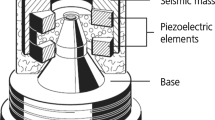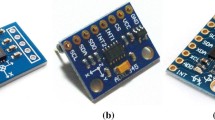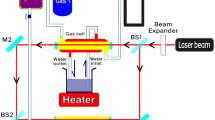Abstract
A laser pistonphone system capable of measuring the sensitivity modulus and phase of microphones is proposed. For the primary vibration calibration, the sine-approximation method has been applied which is used to calculate the complex sensitivity of accelerometers. This method is based on a laser interferometer with quadrature output instead of the fringe-counting method that is used in conventional laser pistonphones. Here, the laser pistonphone system based on the sine-approximation method with the quadrature signal is proposed and the measured results are compared to those obtained by the reciprocity method. The measured sensitivity with the proposed method agrees well with the result of the reciprocity method for the infrasound range. However, in case of the phase sensitivity, the discrepancy is relatively high in comparison to the sensitivity modulus. The results show that the proposed system is capable of calibrating the complex sensitivity of microphones. The improvement of the uncertainty and extension of the frequency range can be achieved by modification of the excitation system for obtaining the required stable excitation with long stroke.








Similar content being viewed by others
Change history
20 August 2020
The 3rd author, Triantafillos Koukoulas had changed his affiliation in March. The detail of new address was not firmly decided at the period for submitting the proof of manuscript and the address in the current form is no longer valid.
References
IEC 61094-1:2000. (2000). Measurement microphones—Part 1: Specification for laboratory standard microphones.
IEC 61094-2:2009. (2009). Measurement microphones—part 2: Primary method for pressure calibration of laboratory standard microphones by the reciprocity technique.
Barham, R. (2003). Report on key comparison CCAUV.A-K1. Metrologia, 40, 09002.
Sinojmeri, M. (2009). Final technical report for key comparison CCAUV.A-K2. Metologia, 46, 09006.
Barham, R. (1994). The NPL laser pistonphone. Journal of Low Frequency Noise, Vibration, 12, 36–38.
Barham, R., & Goldsmith, M. (2007). The application of the NPL laser pistonphone to the international comparison of measurement microphone. Metrologia, 44, 210–216.
Sadikoglu, E., Bilgic, E., & Karaboce, B. (2004). A laser pistonphone based on self-mixing interferometry for the absolute calibration of measurement microphones. Applied Acoustics, 65, 833–840.
He, W., He, L., Zhang, F., Rong, Z., & Jia, S. (2016). A dedicated pistonphone for absolute calibration of infrasound sensors at very low frequencies. Measurement Science and Technology, 27, 025018.
IEC 16063-11:1999. (1999). Methods for the calibration of vibration and shock transducers—Part 11: Primary vibration calibration by laser interferometry.
Bruns, T., Ripper, G., & Täubner, A. (2014). Final report on CIPM key comparison CCAUV.V-K2. Metrologia, 51, 09002.
Dobosz, M., Usuda, T., & Kurosawa, T. (1998). Methods for the calibration of vibration pick-ups by laser interferometry: I. Theoretical analysis. Measurement Science and Technology, 9, 232–239.
Zhang, F., He, W., He, L., & Rong, Z. (2015). Acoustic properties of pistonphones at low frequencies in the presence of pressure leakage and heat conduction. Journal of Sound and Vibration, 358, 324–333.
Gerber, H. (1964). Acoustic properties of fluid filled chambers at infrasonic frequencies in the absence of convection. Journal of the Acoustic Society of America, 36, 1427–1434.
Jackett, R. (2014). The effect of heat conduction on the realization of the primary standard for sound pressure. Metrologia, 51, 423–430.
He, W., Zhang, F., He, L., & Rong, Z. (2015). A study on the pressure leakage correction of pistonphones at infrasonic frequencies. Journal of Sound and Vibration, 335, 105–114.
Hansen, P. C. (1998). Rank-deficient and discrete ill-posed problems. Philadelphia: SIAM.
Avison, J., & Barham, R. (2014). Final report on key comparison CCAUV.A-K5: pressure calibration of laboratory standard microphones in the frequency range 2 Hz to 10 kHz. Metrologia, 51, 09007.
JCGM 100:2008. (2008). Evaluation of measurement data—Guide to the expression of uncertainty in measurement.
Cox, M. G. (2002). The evaluation of key comparison data. Metologia, 39, 589–595.
Ratel, G. (2005). Evaluation of the uncertainty of the degree of equivalence. Metrologia, 42, 140–144.
Qiao, S., et al. (2017). Final report of CCAUV.V-K3: Key comparison in the field of acceleration on the complex charge sensitivity. Metrologia, 54, 09001.
Lee, Y.-H., Jung, Y., Kwak, J.-H., & Hur, S. (2014). Development of capacitive-type MEMS microphone with CMOS amplifying chip. International Journal of Precision Engineering and Manufacturing, 15, 1423–1427.
Suh, J.-G., Cho, W.-H., Kim, H.-Y., Cui, Z., & Suzuki, Y. (2019). Sensitivity measurement of a laboratory standard microphone by measuring the diaphragm vibration. Applied Acoustics, 143, 38–47.
Acknowledgements
This work was funded by Korea Meteorological Administration Research and Development Program under Grant KMI2018-02310 and KRISS under the project ‘Improvement of Measurement Standards and Technology for Optical Metrology’, Grant GP2019-0001-01.
Author information
Authors and Affiliations
Corresponding author
Additional information
Publisher's Note
Springer Nature remains neutral with regard to jurisdictional claims in published maps and institutional affiliations.
Rights and permissions
About this article
Cite this article
Suh, JG., Cho, WH., Koukoulas, T. et al. Development of a Laser Pistonphone System to Calibrate the Sensitivity Modulus and Phase of Microphones for Infrasonic Frequencies. Int. J. Precis. Eng. Manuf. 21, 1279–1289 (2020). https://doi.org/10.1007/s12541-020-00338-4
Received:
Revised:
Accepted:
Published:
Issue Date:
DOI: https://doi.org/10.1007/s12541-020-00338-4




